


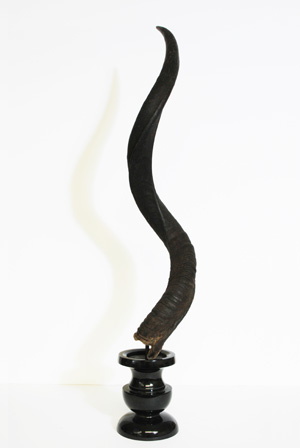
クーズーの角
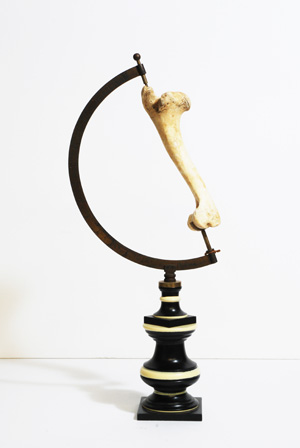
ヤギ(雑種)右上腕骨
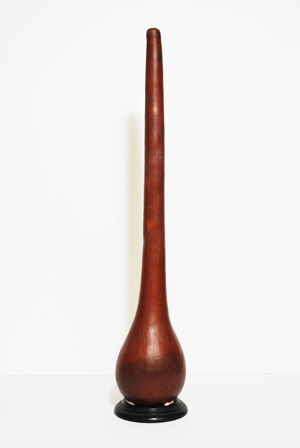
笛
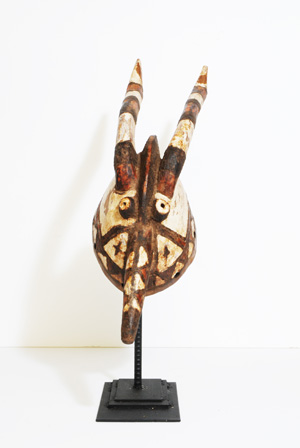
アンティロープ・マスク(モシ族)
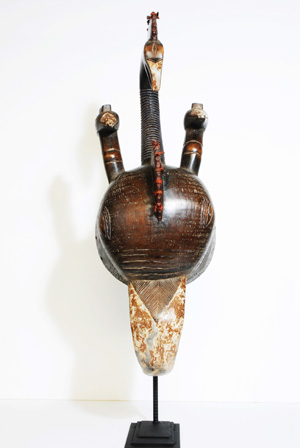
サイチョウ・マスク(グロ族)
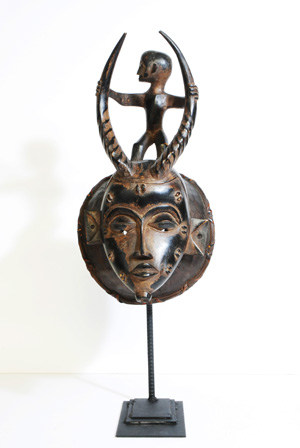
アンティロープ・マスク(セヌフォ族)
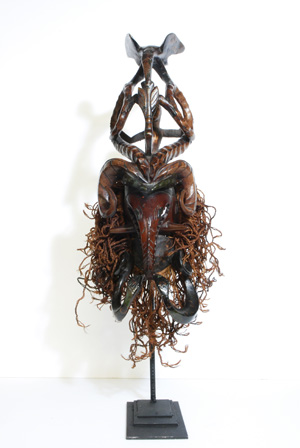
守護霊マスク(グロ族)
 展示標本 (2012.8.6〜2013.2.1)
展示標本 (2012.8.6〜2013.2.1)小ケース1:クーズーの角
年代未詳、乾燥標本、高720 幅150-130、個人蔵
クーズーはアフリカ東部から南部にかけて生息する大形のレイヨウ(アンティロープ)で、肩高150センチ、体重300キログラムに達する。角は二回転あまり捩じれながら伸長し、最大で180センチ近くになることもある。おもに疎林に住み、草原には少ない。角の捩れは成長のプロセスからもたらされるものである。角は雄のみにあり、雌を獲得するために発達したと考えられる。
Horn of Greater Kudu (Tragelaphus strepsiceros)
Date unknown, Dried specimen, H720 W150/130, Private collection
The kudu is a large antelope that inhabits areas of eastern and southern Africa. It stands at about 150 centimeters in height and weighs as much as 300 kilograms. Its horns twist around more than twice as they grow and can grow to sizes as great as 180 centimeters. For the most part, the kudu lives in open forest and rarely inhabits grasslands. The horns twist as part of the kudu’s growth process. Only male had evolved horns for sexual selection.
小ケース2:ヤギ(雑種)右上腕骨
2002年、東洋と小笠原村父島より採集。
動物の四肢は運動を司る器官である。骨格形態によって骨の強度や関節の位置・可動性、筋の付着位置・走向が決められるため、動物の運動性能は骨格形態に大きく左右される。例えばヤギ(鯨偶蹄類、ウシ科)のような走行に適応した動物の移動運動は、矢状面上の四肢の伸展・屈曲運動に依存する。例えばヤギの上腕骨では、近位の浅い椀状の肩関節と遠位の滑車状の肘関節はそれぞれ肩甲骨と前腕に関節するが、これらの構造はともに関節の運動方向を一平面上に制限するのに役立つ。また、近位端の突起が肩関節の伸筋(棘上筋)の強力なテコとして機能しているように、四肢の骨格筋も伸展・屈曲方向への運動が支配的となるよう分布している。
Right humerus of goat (Capra hircus)
Collected at Ogasawara Village, Chichi-jima, Tokyo, in 2002.
Most animals use their limbs for locomotion. The bone strength, the joint position and its mobility, and the muscle origin/insertion and orientation all depend on the shape of bones. Locomotor ability of the animal therefore varies by the shape of bones. Locomotion of cursorial animals, such as goat (Bovidae, Cetartiodactyla) for example, relies on the extension/flexion of the joints on the sagittal plane. In the humerus, both the shoulder-, a shallow cup-shaped surface on the proximal portion which occupies the scapula, and the elbow joints, a trochlear structure on the distal end which occupies the antebrachium, restricts the joint rotation to a single plane. The muscles also distribute to emphasize the extension/flexion of the joints—a process on the proximal end provides a powerful lever for the shoulder extensor muscle, m. supraspinatus.
小ケース3:笛
20世紀、フィリピン、瓢箪
植物の果実を利用して作られた民族楽器。穴を開けただけの単純なものながら、楽器として必要な「共鳴」の機能を充分に満たしている。自然の造形の妙に応える、という人間の創造姿勢の美しさに溢れている。
Flute
20th century, Philippines, Gourd
A folk instrument made using the fruit of a plant. The flute is little more than a hole opened in the fruit, but it is sufficiently equipped with the function necessary of a musical instrument: resonance. It is filled with the beauty of man’s creation, which responds to the exquisite creation of nature.
中ケース:アフリカ仮面コレクション
アフリカの仮面は、部族社会特有の儀礼や風習に使われることから、伝統的に民族学の研究資料と見なされてきた。しかし、製作技術の水準の高さはもとより、象徴学や造形性においても際立っていることから、アート・ワークとして価値づけられることもある。写実的な表現を超えた、その抽象的なフォルム、発想の豊かさには、瞠目すべきところがある。
1.アンティロープ・マスク
モシ族(ブルキナファソ)
西アフリカに位置する内陸国ブルキナファソ共和国のモシ族が儀礼に用いた仮面。これを被ると守護霊に化身する。アンティロープはモシ族の神話のなかに始祖動物として登場する「コバ」と同一視されている。(UMUTafrica0021)
2.サイチョウ・マスク
グロ族(コートジボワール)
グロ族の古い仮面。サイを象徴する仮面で、頭頂部にサイチョウを頂く。グロ族の動物仮面は、高位の精霊仮面の登場を促す、前座として役割を担う。抽象化された顔の表現が面白い。(UMUTafrica0022)
3.アンティロープ・マスク
セヌフォ族(コートジボワール)
セヌフォ族の仮面は、細部にわたる装飾性に特徴がある。両腕を拡げ、二本の角を掴んでいる小人像は祖先霊か。仮面本体が正面観で表されるのに対し、上部の小人像の顔が側面観をとっている。(UMUTafrica0023)
4.守護霊マスク
グロ族(コートジボワール)
守護者として崇められる様々な動物を組み合わせた仮面。一個の木塊からこの造形を彫り出す作業は、伝統的なものとはいえ、凡百の想像を超えている。(UMUTafrica0024)
African Mask Collection
Having been used in rites and customs proper to tribal societies, African masks have been traditionally regarded as a research material for ethnological studies. However, without even mentioning the high level of technical skill their production requires, they equally stand out from a symbological and plastic point of view, and as such have been valued as artworks. Their abstract forms transcending realistic expression, as well as the richness of their conception, are to be gazed in wonderment.
1. Antelope Mask (Koba)
Mossi Tribe (Burkina Faso)
This mask was used in rites by the Mossi tribe, located in the West-African inland country of Burkina Faso. Whoever wears it is said to be transformed into a tutelary spirit. The antelope is regarded as being identical to the Koba, the primal animal which appears in the mythology of the Mossi tribe. (UMUTafrica0021)
2. Anthropomorphic Bird Mask
Guro Tribe (Côte d'Ivoire)
This ancient mask of the Guro tribe symbolizing a rhinoceros bears a rhinoceros hornbill overhead. Animal masks of the Guro tribe serve in opening ceremonies to prompt the entry of masks symbolizing higher spirits. The abstract facial expressions are particularly interesting. (UMUTafrica0022)
3. Antelope Mask
Senufo Tribe (Côte d'Ivoire)
Masks of the Senufo tribe are characterized by their detailed ornamentation. The small human figure raising its arms to grasp two horns may figure the spirit of the ancestors. Whereas the mask itself is figured in its frontality, the face of the small human figure on the upper part is represented in profile. (UMUTafrica0023)
4. Anthropomorphic Animal Mask
Guro Tribe (Côte d'Ivoire)
This mask combines several animals worshipped as tutelary figures. However traditional its technique may be, the actual task of curving out this form from a single piece of wood defies the imagination. (UMUTafrica0024)
解説文執筆・翻訳
西野 嘉章(本館館長・教授、博物館工学・美術史学)
松原 始 (本館特任助教、動物行動学)
藤原 慎一(本館特任助教、機能形態学・古脊椎動物学)
大澤 啓 (本館特任研究員、美学・日仏研究)
写真撮影
松本 文夫(本館特任准教授、建築学)
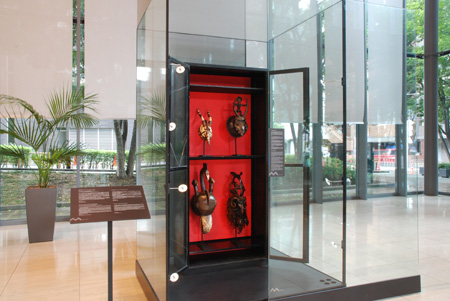
モバイルミュージアムの展示(アフリカ仮面コレクション)
他の展示期間の展示物
2007年1月〜2007年7月
2007年7月〜2008年2月
2008年2月〜2008年8月
2008年8月〜2009年2月
2009年2月〜2009年7月
2009年8月〜2010年1月
2010年2月〜2010年7月
2010年8月〜2011年1月
2011年1月〜2011年7月
2011年8月〜2012年1月
2012年1月〜2012年7月
2012年8月〜2013年2月
2013年2月〜2013年8月
2013年8月〜2014年1月
2014年2月〜2014年11月
2014年11月〜2015年7月
2015年8月〜2016年1月
2016年2月〜2016年7月
今までのトップページの連続スライドショー
興和不動産本社におけるモバイルミュージアム(非公開)
ページの先頭に戻る